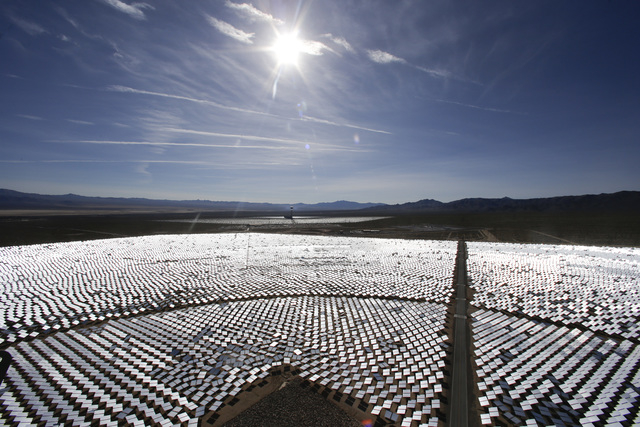Ivanpah solar plant changes Nevada’s landscape

Tourists steering north on Interstate 15 from California have long been greeted by undeniable symbols that they were visiting a place apart when they approached the state line and entered Nevada.
Audacious casinos at Primm flank the interstate and beckon visitors day and night. The lights, the marquee, the roller coaster: Travelers know they’re not in Pasadena anymore.
But these days another shiny sign of Nevada’s difference is drawing even more attention. It’s the Ivanpah Solar Electric Generating System, which covers approximately five square miles of federal land with 350,000 mirrors near the state line. It opened Feb. 13 and is the largest solar power plant of its type on the planet.
With three generating units in all, the $2.2 billion facility can produce approximately 400 megawatts, or about enough power to light 140,000 homes. Although solar energy at present supplies less than 1 percent of the nation’s current needs, according to The Associated Press, the Ivanpah facility has become a shimmering symbol of the changes taking place throughout the desert West and across Nevada. Its advocates call its existence nothing less than marking the “dawn of a new era in power generation in the United States.”
Whether that $2.2 billion would have been more efficiently spent outfitting thousands more homes with their own solar panels is just one unanswered question critics have leveled at such projects. That’s the intriguing aspect of the solar phenomenon: It generates almost as many opinions as megawatts.
Most of the financing for the facility, $1.6 billion, has been secured by developer BrightSource through Department of Energy loans, but Google has invested $168 million in the project.
The challenge of a solar-powered future isn’t hard to spot. It’s still far more expensive than coal and other energy sources when it comes to producing megawatts, according to the U.S. Energy Information Administration.
The trouble with that simple dollar comparison is that it doesn’t take into account other very real costs that come in the form of pollution and public health. Add in the long-term impacts, and the cost of building a renewable energy infrastructure isn’t as audacious.
Its critics raise issues about its expense and environmental impact, but such arguments haven’t stopped hundreds of projects of varying sizes from beginning to take shape in places most casual visitors would consider coyote and rattlesnake country. The result of this largely government-financed boom can only help improve the development of rural Nevada, which has a long and extremely mixed history of growth and abandonment of its mining metropolises.
Approximately 250 miles away from Primm, the Crescent Dunes Solar Energy Plant spreads out near Tonopah. It’s a 110-megawatt facility developed by SolarReserve and backed by a $737 million Department of Energy loan. It’s touted as the “most advanced solar plant in the world.”
Not far from where I-15 leaves Nevada, the 350-megawatt K-Road solar project is taking shape on the reservation of the Moapa Band of Paiutes Indians. It enjoys the advantage of having a purchase agreement signed by the Los Angeles Department of Water and Power.
With California law mandating substantially increased use of renewable energy by 2020, Nevada seems in a perfect position to benefit from its proximity and its sunshine.
Like the atmosphere around so many of the gold and silver mining boom towns of a previous era, there’s no shortage of hot air and hustle to go with the growth of the renewable energy market in Nevada. Whether the enormous startup costs eventually turn some of the largest solar projects under consideration into so many Rhyolites and Rawhides remains to be seen.
But the change coming across our desert landscape is undeniable.
John L. Smith’s column appears Sunday, Tuesday, Wednesday, Thursday and Friday. E-mail him at jsmith@reviewjournal.com or call (702) 383-0295.












